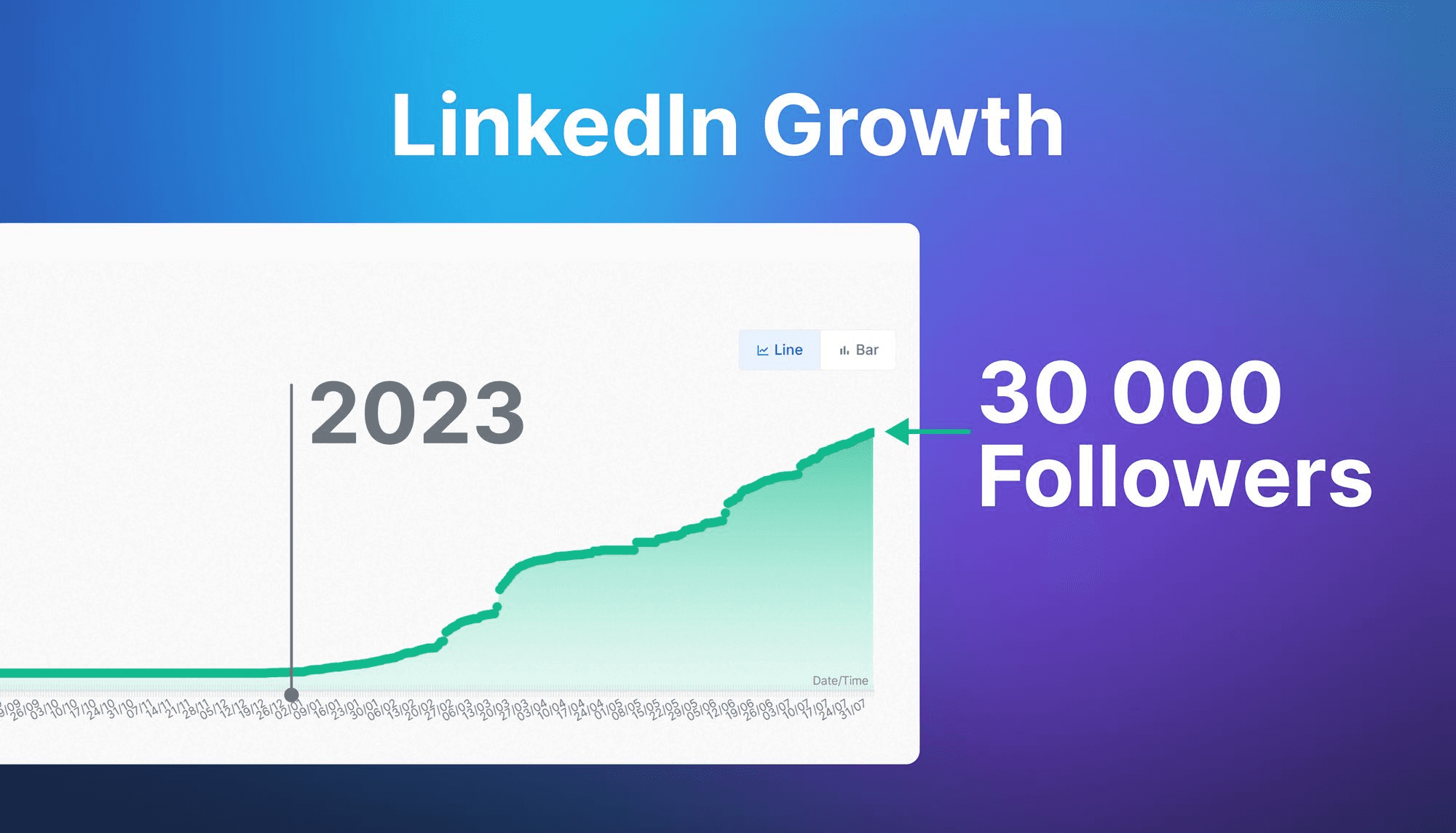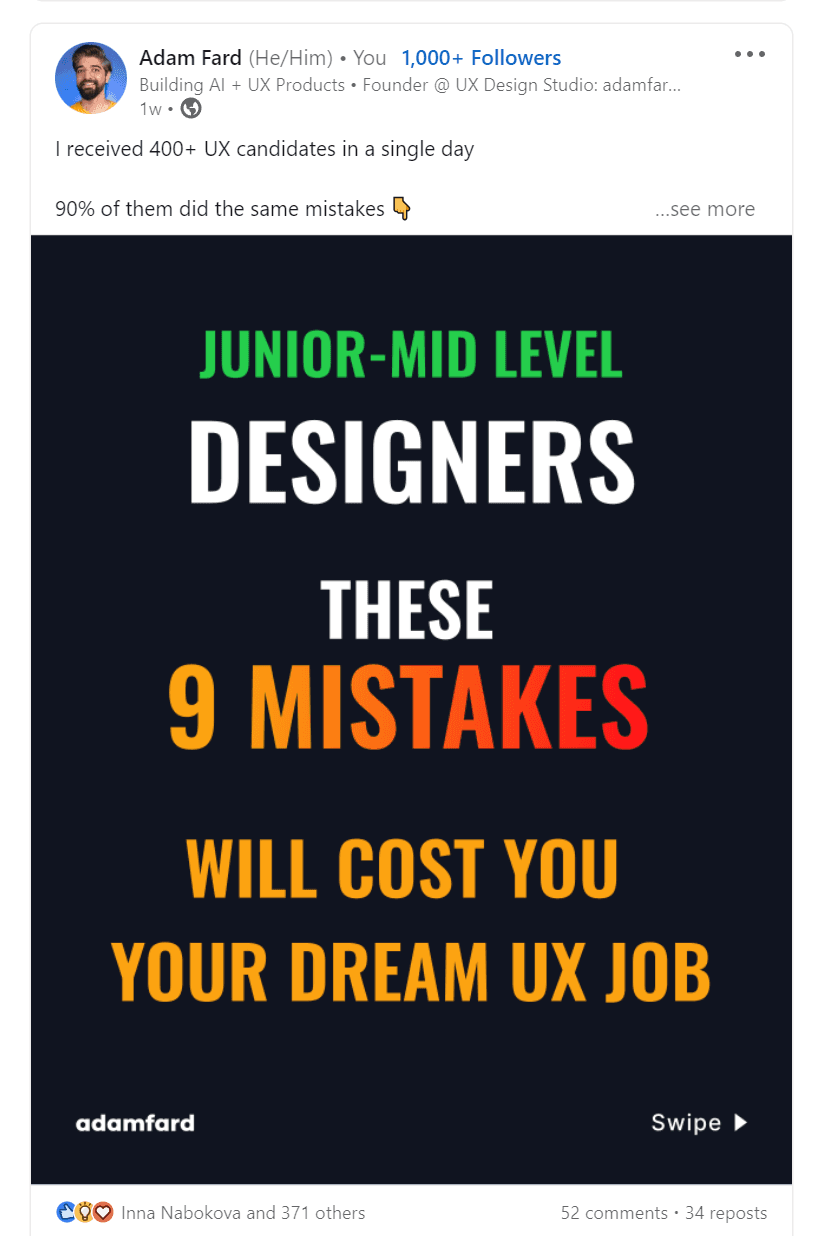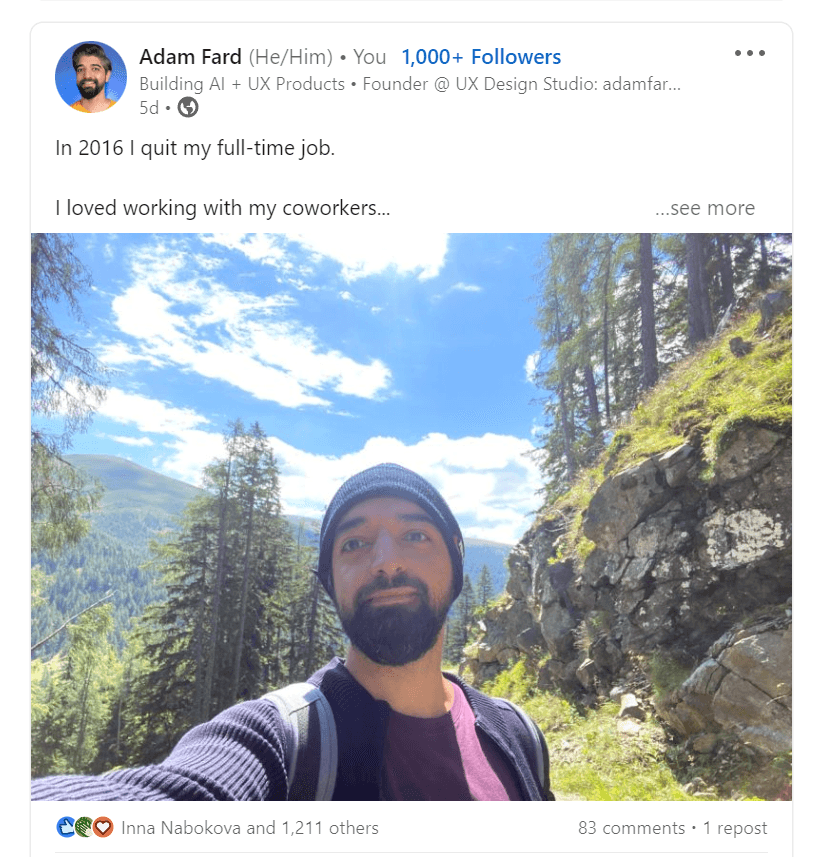Aug 5, 2023
Are you feeling lost in the massive ocean that is LinkedIn?
Are you broadcasting content into the void, hoping against hope to see results?
Are you sharing links to your weekly blog posts and getting nothing in return?
If any of these scenarios feel familiar to you, then keep reading.
This week, I achieved the remarkable feat of reaching 30,000 followers on LinkedIn, and I am eager to share the strategies that worked for me.
Six months ago, I was in the same boat as you, but everything changed when I decided to shift my focus to not just creating more content but also becoming a part of it.

1. Engage
LinkedIn is more than just a platform to showcase your professional achievements; it's a community. Like any community, to truly reap the benefits, you must engage and participate. Passive observation will only get you so far. To grow your LinkedIn account, you need to be actively involved.
Interact with Peers
On LinkedIn, your peers are not just your colleagues or acquaintances; they are potential collaborators, clients, mentors, or even friends. Engage with them. Comment on their posts. Share your insights. Not just a casual "Nice post" or "Great article", but something that adds value to the conversation. Do you agree with their points? Do you have a different perspective? Can you add more information? Genuine, thoughtful interactions will not only get you noticed but will also strengthen your professional relationships.
Provide Value
LinkedIn is a professional platform, and the best way to stand out is by providing professional value. How do you do that? By leveraging your expertise. Share your knowledge, your insights, your experience. Answer questions. Offer help. The more value you provide, the more you'll be seen as an authority in your field, which can significantly boost your follower count.
Pick Your Interests
Engagement doesn't mean you have to comment on every single post you come across. Be selective. Engage with topics that genuinely interest you, resonate with your field of work, or align with your professional goals. Engaging with relevant content will not only be more enjoyable but will also increase your visibility among the right audience.
Balance Time and Effort
Let's face it; engaging on LinkedIn is time-consuming. It comes second only to content creation. However, it's a worthwhile investment. The time and effort you put into engaging with others can pay off in the form of increased visibility, stronger professional relationships, and ultimately, more followers.
But remember, engagement should never feel like a chore. If you're not enjoying the process, it's likely that your interactions won't come across as genuine. So, pace yourself. Find a balance that works for you. Engage in a way that's sustainable and enjoyable in the long run.
Engagement is Reciprocal
When you engage with others, they are more likely to engage with you. This reciprocal relationship is at the heart of any social media platform, including LinkedIn. By engaging with others, you're encouraging them to do the same with your content. This can lead to increased visibility and reach for your posts, contributing to your account's growth.
In the next section, I'll be delving into the importance of listening and how being a good consumer can transform you into a better creator. Stay tuned!
2. Listen
The importance of listening cannot be overstated in the world of social media, especially on a professional platform like LinkedIn. It's the secret ingredient that can give your content that extra relevance, that extra appeal. It's not just about creating content; it's about creating content that your audience can connect with. So, how do we do that? We listen.
Tune Into the Chatter
Active listening involves keeping your eyes and ears open to the conversations happening around you. This could be the general discourse in your industry, trending topics on LinkedIn, or the buzz within your own network. Pay attention to what's being discussed. What are the hot topics? What's causing a stir? What are people agreeing or disagreeing about?
The pulse of these discussions can offer you invaluable insights into what's relevant, what's trending, and what's likely to get your audience talking.
Absorb and Apply
Listening is a passive activity, but it doesn't stop there. Once you've gathered all these insights, it's time to put them into action. Use this knowledge to fuel your content creation process. Incorporate the trends and topics that you've discovered into your content. Address the needs and pain points of your audience. Create content that not only speaks to them but also speaks for them.
For instance, if you notice that a significant part of your audience is struggling with remote work, consider creating content around that. Share tips for managing work-life balance, staying productive, or maintaining mental health while working from home.
Stay Curious
Finally, always keep that curiosity alive. Never stop learning. As I mentioned before, I gained so much knowledge and insight simply by observing and understanding the needs of my audience. But remember, this isn't a one-time activity. Your audience, their needs, the industry trends - everything evolves over time. Keep listening, keep understanding, and keep adapting your content strategy accordingly.
In the next section, we'll look at how to maintain consistency in your posts without overwhelming yourself or your audience. How often is too often, and how little is too little? Stay tuned to find out.
3. Be Consistent and Know Your Limits
The world of social media can often feel like a race - a race to post the most, the fastest, the most frequently. But when it comes to LinkedIn, more isn't always better. You don't need to bombard your followers with multiple posts a day. Instead, what matters most is the consistency and quality of your content.
The Power of Consistency
Think of your LinkedIn presence like a television show. Your followers are your viewers. If they know that you post valuable content at a certain frequency - be it daily, twice a week, or even just once a week - they will begin to anticipate your posts, just like viewers eagerly await the next episode of their favorite show. Consistency cultivates expectation and anticipation among your followers, and that can be a powerful tool to keep them engaged and coming back for more.
Knowing Your Limits
While consistency is important, it's equally critical to understand and respect your own limits. High-quality content creation takes time and effort. Trying to maintain an unrealistic posting schedule can lead to burnout, and the quality of your content may suffer as a result.
So, find a rhythm that works for you. It could be once a day, once every two days, or even just once a week. What's essential is to keep it consistent and to ensure that each post delivers value.
Consistent Value Delivery
When it comes to LinkedIn, quality trumps quantity. Each post you make should deliver value to your audience. Whether it's a unique insight, a useful piece of advice, or an engaging story, make sure your posts are more than just digital noise.
Remember, my long-time followers - many of whom eventually became my leads and clients - weren't drawn to the quantity of my content, but to its regularity and the consistent value it delivered. They knew that whenever a post appeared from me, it would be worth their time.
Being Flexible
Lastly, remember that being consistent doesn't mean being rigid. As you grow and evolve, your posting frequency and the type of content you create may change, and that's perfectly okay. Consistency is about reliability, not repetition.
Don't be afraid to reassess and adjust your strategy as needed. What's most important is that you remain a consistent presence on your followers' LinkedIn feeds, delivering valuable content that they look forward to consuming.
As we venture further into the secrets of growing your LinkedIn account, remember that consistency is your faithful ally. Embrace it, and watch as your follower count begins to climb. Stay tuned for more practical tips on supercharging your LinkedIn strategy.
4. Create
Creating valuable content is an art in itself. It’s about much more than just sharing information; it’s about sparking curiosity, fostering engagement, and building lasting relationships with your audience. So, how do you create such content on LinkedIn? Here are some actionable strategies.
Understand Your Audience
The first step in creating valuable content is understanding who you're creating it for. Delve into your audience's needs, interests, and pain points. What challenges are they facing in their professional lives? What knowledge or insights could help them overcome these challenges? The more you understand your audience, the more value you can provide.
Provide Solutions
Once you know your audience’s challenges, craft your content to provide solutions. If your audience is primarily made up of startup founders, maybe they struggle with raising capital or building a successful team. Address these challenges in your content, providing insights, advice, and tips based on your own experiences and expertise. The aim is to give away so much value that people can't believe it's free!
Keep it Unique and Personal
LinkedIn is flooded with content, so how can yours stand out? By being unique and personal. Share your own experiences, anecdotes, and lessons learned. A story from your professional journey that your audience can learn from and relate to will always be more engaging than a generic piece of advice.

Make it Actionable
The most valuable content gives the audience something they can implement immediately. Whether it's a step-by-step guide, practical tips, or actionable advice, making your content practical increases its value exponentially.
Stay Current
Stay updated with industry trends, news, and discussions. By creating content that's timely and relevant, you show your audience that you're a thought leader who's on top of the latest developments in your field. This not only makes your content valuable but also builds your credibility and authority.
Encourage Engagement
Lastly, strive to create content that encourages engagement. Ask questions, seek opinions, stir up a discussion. Engaged followers are more likely to see your content in their feed due to LinkedIn's algorithm, which in turn leads to even more engagement.
The key to creating truly valuable content on LinkedIn is to go beyond the surface level. Dive deep into your audience's needs, offer practical and timely advice, and share from your unique perspective and experience. Remember, when it comes to LinkedIn, more value equals more engagement, more followers, and ultimately, more growth.
But the journey doesn't stop here. We've understood how to create valuable content. Up next, we're going to explore the pivotal role of engagement in your LinkedIn growth strategy. So, stay tuned and let's continue growing together on LinkedIn!
5. Niche Down to Niche Up
Navigating the colossal landscape of LinkedIn might feel like traversing a labyrinth. With its 700 million users spread across various fields and interests, it can be challenging to make your voice heard above the noise. That's where the magic of niching down comes into play.
Start Small, Go Big
When I first started on LinkedIn, I knew I needed a strategy that would make me stand out. I niched down. What does that mean? Well, it's about focusing on a very specific area or interest. By becoming an expert in a distinct field, you can quickly establish authority and credibility.
Let's take an example - if your area of interest is digital marketing, niching down could mean focusing specifically on content marketing for startups or SEO for e-commerce websites. By doing this, not only do you stand out amongst other digital marketing professionals, but you also become a go-to source of knowledge for that particular niche.
However, while niching down is a fantastic strategy to gain initial visibility and engagement, it does come with a caveat - your growth within a niche could hit a ceiling. You might find that you've tapped the potential of that niche, and the follower growth and engagement begin to plateau.
Breaking the Barriers
So, what's the next step once you've outgrown your niche? That's when you 'niche up.' Now, this doesn't mean abandoning your initial focus. It means building upon the solid foundation you've created within your niche and expanding your content to appeal to a larger audience.
Continuing with our earlier example, if you've established a solid following by focusing on content marketing for startups, you might start discussing broader topics related to startups, like fundraising strategies or recruitment tips. Alternatively, you could delve into related areas of digital marketing such as email marketing or social media strategy.
While doing this, ensure that you maintain the core principles that made you successful in your initial niche. The same level of depth, the same quality of content, and the same passion should be evident in your broader content as well.
Balancing Act
Niching up is a balancing act. It's about widening your scope without diluting your brand's essence. It's about reaching a larger audience while still providing the in-depth content your initial followers have come to love.
Just as a tree grows both upwards and outwards, your LinkedIn growth strategy should mimic that natural progression. Start by digging deep (niching down), establishing your roots, and then spread out, reaching for the sky (niching up).
Remember, this growth process is a journey that requires strategic planning, patience, and adaptability. Each step takes time and effort, but the reward is worth it. As we continue this journey together, stay tuned for the next article where we explore the importance of authenticity and personal branding on LinkedIn.
6. Test, Test, and Test
When it comes to LinkedIn, or any social media platform for that matter, there's no one-size-fits-all strategy. Different content formats and topics can yield different results for different individuals or businesses, and the only way to truly know what works for you is to test.
Don't restrict yourself to what you know or what you've always done. Embrace the unfamiliar. Break away from your comfort zone and experiment with different types of content. You might be surprised by what resonates with your audience.
Experiment with Formats
Maybe you've only been sharing text-based posts until now. How about trying a video? Or an infographic? Perhaps a poll to engage your audience and get their opinions on a relevant topic? Or how about a slide deck that dives deep into a specific subject?
Each format has its own strengths. Videos can be highly engaging and personal. Infographics can distill complex information into digestible, visual chunks. Polls can stir up engagement and conversation. Slide decks can provide detailed insights and information.
Play with Topics
Similarly, experiment with a variety of topics. While it's essential to stay within your area of expertise or industry, don't be afraid to tackle different aspects of it. If you've only been discussing technical aspects of your industry, try discussing its future trends. Or perhaps share some personal stories about your experiences in the field. Even a behind-the-scenes peek at your work life can be interesting and relatable content for your followers.
Give It Time
Importantly, remember to be patient. Just as it takes time for a seed to grow into a plant, it also takes time for your content to gain traction. Give each new format or topic at least three to four tries before deciding whether it's working for you or not.
A single post can't provide enough data to make a sound judgement. But after three or four attempts, you can start to gauge whether a certain content format or topic resonates with your audience. Keep a close eye on your engagement metrics - likes, comments, shares, and most importantly, the quality of the conversation happening around your posts. This will help you identify what kind of content makes your audience tick.
Learn and Adapt
Finally, testing is not just about trying new things. It's also about learning from the outcomes and adapting your strategy based on your findings.
If a certain content format or topic performs exceptionally well, make a note of it. Incorporate more of it into your content plan. If something doesn't work, don't see it as a failure but as a learning opportunity. It brings you one step closer to understanding what truly works for you.
In the ever-evolving landscape of LinkedIn, staying flexible, being open to experimentation, and continually testing is your ticket to growth and success. And remember, you're not alone in this journey. We're all learning, experimenting, and growing together. So, what's your next test going to be? Stay tuned for the next article where we'll delve into the powerful world of LinkedIn analytics to help you make data-driven content decisions.
7. Share Your Story
We often think that professional platforms like LinkedIn are no place for personal stories. We fear being seen as too human, too vulnerable. But the truth is, your audience craves authenticity. They want to connect with a real person, not a corporate robot. They want to see the person behind the achievements, the human side of success. And that's where sharing your story comes in.
The Power of Vulnerability
We've all heard the saying "people do business with people they know, like, and trust." By sharing your journey – the triumphs and the trials, the victories and the vulnerabilities – you're letting your audience in. You're giving them a chance to know you, to like you, and ultimately, to trust you.
For the longest time, I shied away from sharing my personal journey. But once I mustered up the courage to do so, I was met with an outpouring of empathy, support, and connection. My audience connected with my story, they related to my experiences, and it made me more real to them.

Wins and Failures – The Full Picture
Share your wins, by all means. Your achievements are a testament to your skills, your expertise, your dedication. But don't shy away from sharing your failures too. We all stumble, we all fall. And it's often in these failures, these stumbling blocks, that the most profound learning and growth happen.
Your audience will appreciate your honesty. It shows them that you're not just a success story but a fighter who has overcome challenges, a learner who has grown from failure. It makes you relatable, approachable, and human.
Building Personal Branding Through Stories
Your story is not just a series of events; it's a tool for building your personal brand. It shows who you are, what you stand for, what you've been through, and where you're going. It gives your audience a narrative to follow, a journey to join.
So, how can you effectively share your story on LinkedIn? What elements should you include, and how can you make your narrative engaging? These are questions we will explore in the next article, as we dive into the art of storytelling and its impact on personal branding on LinkedIn.
The process of growing my LinkedIn following to 30,000 did not happen overnight, and it wasn't always smooth sailing. But every step, every strategy, every success, and failure was a part of my journey. These seven steps, while simple in concept, can make a world of difference when implemented thoughtfully and consistently.
But remember, this is not the end, but just the beginning. The journey of growth and discovery never ends. So, stay tuned, keep learning, keep growing, and let's embark on this LinkedIn journey together.
Discover the power of organic growth. With a community-focused strategy, you can grow your brand without ever needing to "pay to play."
Take the first step towards building your community. Click the button below to schedule a free consultation with us.
Let's grow together!

Latest Blog Posts
Social Media Plan: Ultimate Guide to Crafting an Effective Strategy
97 ChatGPT Prompts to 10x your Social Media Success
7 Steps to Grow Your LinkedIn Account
Top 10 Reasons People Buy Twitter Followers (And What You Should Consider)
The Complete Guide to Social Media Management Services
Corporate Branding vs. Personal Branding for Startups
The 10 Commandments for Social Media Growth in 2023
How to increase Twitter followers (now X) and how I got 20k+ followers!
Building a Powerful Personal Brand for Career Success
© 2023 All Rights Reserved. Privacy Policy



